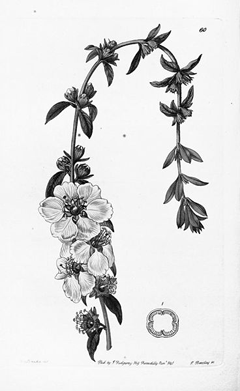 |
|
http://commons.wikimedia.org/wiki/File:Heimia_salicifolia.jpg |
 |
|
Translate this page:
Summary
Physical Characteristics

 Heimia salicifolia is a deciduous Shrub growing to 3 m (9ft 10in).
Heimia salicifolia is a deciduous Shrub growing to 3 m (9ft 10in).
See above for USDA hardiness. It is hardy to UK zone 8. It is in flower from August to September. The species is hermaphrodite (has both male and female organs).
Suitable for: light (sandy), medium (loamy) and heavy (clay) soils and prefers well-drained soil. Suitable pH: mildly acid, neutral and basic (mildly alkaline) soils. It cannot grow in the shade. It prefers moist soil.
UK Hardiness Map
US Hardiness Map
Synonyms
Plant Habitats
Woodland Garden Sunny Edge; Dappled Shade; South Wall. By. West Wall. By.
Edible Uses
Edible Parts:
Edible Uses: Drink
An intoxicating and euphoric drink is made by crushing the wilted leaves in water and leaving the liquid in a sunny position for three days to ferment[192]. In larger quantities this can induce hallucinations and produces a vision that is typically overcast in yellow[192].
References More on Edible Uses
Medicinal Uses
Plants For A Future can not take any responsibility for any adverse effects from the use of plants. Always seek advice from a professional before using a plant medicinally.
Antispasmodic Hallucinogenic Sedative
The leaves are antispasmodic, hallucinogenic and sedative[192]. An infusion serves to stabilize the blood pressure and relieve anxiety[192].
References More on Medicinal Uses
The Bookshop: Edible Plant Books
Our Latest books on Perennial Plants For Food Forests and Permaculture Gardens in paperback or digital formats.

Edible Tropical Plants
Food Forest Plants for Hotter Conditions: 250+ Plants For Tropical Food Forests & Permaculture Gardens.
More

Edible Temperate Plants
Plants for Your Food Forest: 500 Plants for Temperate Food Forests & Permaculture Gardens.
More

More Books
PFAF have eight books available in paperback and digital formats. Browse the shop for more information.
Shop Now
Other Uses
References More on Other Uses
Cultivation details
Easily grown in any well-drained soil in full sun[200]. Especially in the colder areas of the country this plant is best grown against a sunny south or south-west facing wall and given a good mulch of bracken in the winter[200]. The rootstock is fairly hardy in most of Britain, whilst the top growth tolerates temperatures down to about -10 to -15°c[200]. If cut back by severe weather the plant usually grows again from the base[200]. Flowers are produced on the current seasons growth[200]. Plants growing by the side of a greenhouse at Cambridge Botanical Gardens flower freely[11]. This species is closely related to H. myrtifolia, differing mainly in having larger flowers[11]. Any pruning is best carried out in early spring by removing excess growth at the base of the plant[200].
References Carbon Farming Information and Carbon Sequestration Information
Temperature Converter
Type a value in the Celsius field to convert the value to Fahrenheit:
Fahrenheit:
The PFAF Bookshop
Plants For A Future have a number of books available in paperback and digital form. Book titles include Edible Plants, Edible Perennials, Edible Trees,Edible Shrubs, Woodland Gardening, and Temperate Food Forest Plants. Our new book is Food Forest Plants For Hotter Conditions (Tropical and Sub-Tropical).
Shop Now
Plant Propagation
Seed - we have no information for this species but suggest sowing the seed in spring in a greenhouse. Prick out the seedlings into individual pots once they are large enough to handle. Grow the young plants on for at least their first winter in a greenhouse and plant out in late spring or early summer. Mulch the roots well in the autumn to protect them from the cold. Cuttings of half-ripe wood, July/August in a frame[200].
Other Names
If available other names are mentioned here
Native Range
NORTHERN AMERICA: United States (New Mexico, Texas), Mexico (Baja, Nuevo León, San Luis Potosí, Sonora, Tamaulipas, Zacatecas, Aguascalientes, Chiapas, Guanajuato, Guerrero, Hidalgo, Jalisco, México, Michoacán de Ocampo, Nayarit, Oaxaca, Puebla, Querétaro, Veracruz de Ignacio de la Llave) SOUTHERN AMERICA: Jamaica, Guatemala, El Salvador, Brazil, Bolivia, Argentina, Paraguay
Weed Potential
Right plant wrong place. We are currently updating this section.
Please note that a plant may be invasive in one area but may not in your area so it's worth checking.
Conservation Status
IUCN Red List of Threatened Plants Status :

Growth: S = slow M = medium F = fast. Soil: L = light (sandy) M = medium H = heavy (clay). pH: A = acid N = neutral B = basic (alkaline). Shade: F = full shade S = semi-shade N = no shade. Moisture: D = dry M = Moist We = wet Wa = water.
Now available:
Food Forest Plants for Mediterranean Conditions
350+ Perennial Plants For Mediterranean and Drier Food Forests and Permaculture Gardens.
[Paperback and eBook]
This is the third in Plants For A Future's series of plant guides for food forests tailored to
specific climate zones. Following volumes on temperate and tropical ecosystems, this book focuses
on species suited to Mediterranean conditions—regions with hot, dry summers and cool, wet winters,
often facing the added challenge of climate change.
Read More
Expert comment
Author
(Kunth.)Link.
Botanical References
11200
Links / References
For a list of references used on this page please go here
Readers comment
| Add a comment |
|
If you have important information about this plant that may help other users please add a comment or link below. Only comments or links that are felt to be directly relevant to a plant will be included. If you think a comment/link or information contained on this page is inaccurate or misleading we would welcome your feedback at [email protected]. If you have questions about a plant please use the Forum on this website as we do not have the resources to answer questions ourselves.
* Please note: the comments by website users are not necessarily those held by PFAF and may give misleading or inaccurate information.
To leave a comment please Register or login here All comments need to be approved so will not appear immediately.
|
Subject : Heimia salicifolia
|
|
|
|